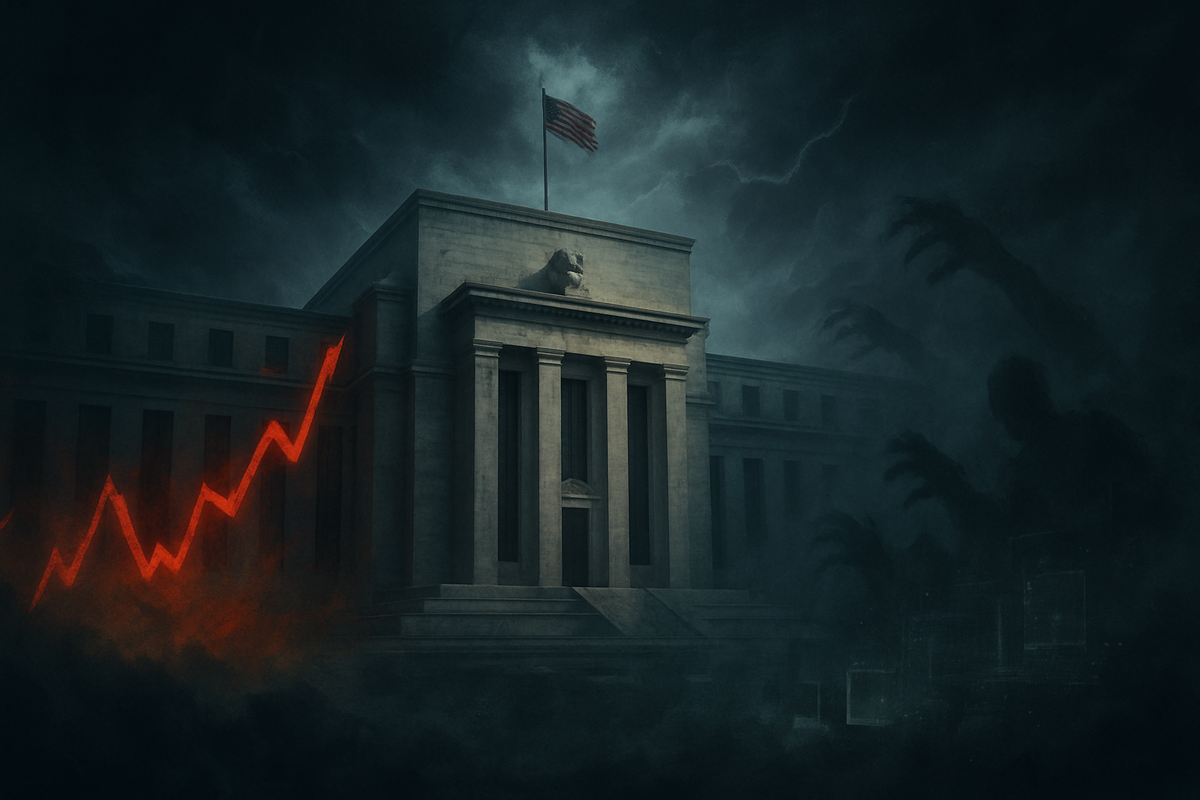
The Federal Reserve stands at a critical juncture, poised to make an interest rate decision that could shape the trajectory of the U.S. economy for months to come. As the Federal Open Market Committee (FOMC) convenes for its October 28-29, 2025, meeting, it faces an unprecedented convergence of challenges: persistent inflation defying its 2% target, unrelenting political pressure from the White House, and a crippling "data blackout" stemming from an ongoing government shutdown. This confluence of factors has created an exceptionally complex environment, forcing the central bank to deliberate with incomplete information and under intense scrutiny, making its upcoming announcement one of the most anticipated in recent memory.
Market participants are widely anticipating a 25-basis-point interest rate cut, a move largely driven by signs of a softening labor market. However, the decision is fraught with peril, as easing too aggressively could reignite inflationary pressures, while a cautious stance risks stifling an already fragile economic recovery. The Fed's actions, and the language accompanying them, will be meticulously scrutinized for clues about its confidence in the economic outlook and its strategic response to these formidable headwinds.
Navigating the Informational Vacuum: A Detailed Look at the Current Crisis
The current economic landscape is characterized by a delicate balance of conflicting signals. As of late October 2025, inflation, while moderating slightly, remains stubbornly above the Federal Reserve's 2% target. The Consumer Price Index (CPI) for September 2025 rose to 3.0% year-over-year, a slight increase from 2.9% in August, though it came in marginally below analysts' forecasts. Core inflation, which strips out volatile food and energy prices, also registered a 3.0% annual increase. The Personal Consumption Expenditures (PCE) Price Index, the Fed's preferred inflation gauge, showed an annual increase of 2.74% in August, with core PCE at 2.91%, still a full percentage point above target. Energy prices, particularly gasoline, contributed significantly to the monthly CPI increase in September, while economists also point to recent tariffs imposed by the administration as a factor contributing to elevated consumer prices.
Compounding this inflationary dilemma is the government shutdown, which commenced on October 1, 2025, due to Congress's failure to pass appropriations legislation. This marks the third shutdown under President Donald Trump and has created an unprecedented "data blackout." Federal agencies responsible for economic data, such as the Bureau of Labor Statistics (BLS) and the Bureau of Economic Analysis (BEA), have suspended the collection and distribution of nearly all reports. While the September CPI data was eventually released on October 24, due to its importance for Social Security adjustments, crucial reports like the September jobs report remain withheld. This informational vacuum leaves the Fed "flying blind," severely hampering its ability to accurately assess the health of the U.S. economy, particularly the labor market, which has shown signs of weakening with unemployment rising to 4.3% in August.
Adding another layer of complexity are the unrelenting political pressures from President Donald Trump. The President has consistently and publicly demanded that Fed Chair Jerome Powell lower interest rates, often resorting to personal attacks and attempting to influence the central bank's independence. Despite these calls, Chair Powell has maintained the Fed's commitment to making policy decisions based on economic data and its dual mandate. However, the weakening labor market now provides a data-driven rationale for the rate cuts President Trump desires, creating a challenging dynamic for the Fed to demonstrate its independence.
Initial market reactions reflect this intricate environment. On October 28, 2025, the US 10-Year Treasury Note yield rose slightly to 3.99%, while US stock futures were largely muted or slightly higher, following a strong rally earlier in the week. The USD/JPY exchange rate saw the Japanese yen strengthen, pulling the pair below the ¥152 threshold, reflecting cautious market sentiment amidst President Trump's visit to Japan and new trade agreements. The market is overwhelmingly pricing in a 25-basis-point rate cut, with futures traders indicating a 98.3% probability, along with expectations that the FOMC might signal an end to quantitative tightening (QT).
Corporate Fortunes in Flux: Winners and Losers from the Fed's Gambit
The Federal Reserve's impending interest rate decision, coupled with persistent inflation and economic uncertainty, will inevitably create a divide between winning and losing public companies. Lower borrowing costs typically stimulate economic activity, but the current environment adds layers of complexity.
Potential Winners:
- Real Estate and Homebuilders: A rate cut directly translates to lower mortgage rates, making homeownership more accessible and stimulating demand. Companies like Pultegroup (NYSE: PHM), D.R. Horton (NYSE: DHI), and Lennar (NYSE: LEN) could see increased sales. Real Estate Investment Trusts (REITs) also benefit from reduced borrowing costs for property investments and become more attractive to income-seeking investors as their dividend yields become more competitive against lower-yielding bonds.
- Technology and Growth Stocks: These sectors are often capital-intensive, relying on debt for innovation and expansion. Lower borrowing costs make these initiatives cheaper and enhance the present value of future earnings, boosting valuations for firms like Apple (NASDAQ: AAPL) and Microsoft (NASDAQ: MSFT), as well as smaller growth-oriented tech companies.
- Consumer Discretionary: Cheaper credit can increase consumers' disposable income, encouraging spending on non-essential goods and services. Retailers like Amazon (NASDAQ: AMZN), auto manufacturers, and travel companies could see an uptick in demand.
- Utilities: Often highly leveraged due to infrastructure investments, utilities like NextEra Energy (NYSE: NEE) or Duke Energy (NYSE: DUK) benefit from reduced borrowing costs for large projects. Their stable dividend yields also become more appealing in a lower-rate environment.
- Highly Leveraged Companies: Businesses with substantial variable-rate debt, such as AT&T (NYSE: T) or Oracle Corp. (NYSE: ORCL), will see a direct reduction in interest expenses, improving net income and cash flow.
Potential Losers or Challenged Sectors:
- Financial Institutions (Banks): A primary concern for banks is the compression of net interest margins (NIMs), the difference between interest earned on loans and paid on deposits. While lower rates might increase loan demand, this may not fully offset reduced margins, potentially leading to decreased profitability for banks like JPMorgan Chase (NYSE: JPM) or Bank of America (NYSE: BAC).
- Companies with High Input Costs and Limited Pricing Power: Persistent inflation means elevated costs for raw materials, labor, and energy. Companies in highly competitive markets, or those selling discretionary goods, may struggle to pass these costs onto consumers without losing sales, squeezing profit margins.
- Consumer Discretionary (Conditional): While a rate cut aims to boost spending, persistent inflation erodes purchasing power. If the rate cut signals a weakening economy despite inflation, consumer confidence may not improve enough to significantly increase spending on non-essentials, limiting benefits or even causing a downturn for companies like Starbucks (NASDAQ: SBUX) or luxury brands.
- Cash-Heavy Companies: Businesses with significant cash reserves or those whose revenue primarily comes from interest income will see reduced returns as prevailing interest rates fall.
The overriding factors of persistent inflation and the data blackout introduce profound uncertainty. Companies with strong pricing power will be better positioned, while the absence of clear economic data makes it challenging for businesses and investors to anticipate market movements, potentially muting the positive effects of a rate cut.
Wider Significance: Global Ripples and Historical Echoes
The Federal Reserve's current predicament extends far beyond its immediate policy decision, embedding itself within broader industry trends, triggering ripple effects across global markets, and raising significant questions about regulatory implications and historical precedents.
Globally, 2025 has seen a divergence in monetary policy. While many major central banks, including the European Central Bank (ECB) and the Bank of England (BOE), have pursued easier money policies, the Federal Reserve maintained a more deliberate stance, only resuming rate cuts in September 2025. This means the Fed is not leading the global rate-cutting cycle as it often has, but its anticipated cuts will nonetheless influence global investment flows. Lower U.S. rates typically encourage capital to flow towards higher-yielding international markets, particularly in emerging economies, supporting global growth but also carrying the risk of creating asset bubbles. It could also reduce the attractiveness of dollar-denominated assets, potentially leading to diversification towards precious metals like gold.
The ripple effects on competitors and partners are substantial. A weaker U.S. dollar, often a consequence of lower rates, makes U.S. exports more competitive and imports more expensive. This impacts countries with strong trade ties to the U.S., such as China, affecting the pricing of goods in the American market. For businesses and consumers, cheaper borrowing can stimulate demand for commodities, housing, and automobiles, encouraging expansion. Conversely, if the rate cut fails to curb inflation or signals a deeper economic malaise, it could dampen confidence and investment.
Beyond monetary policy, the current situation has several regulatory and policy implications. The government shutdown itself is causing an economic loss and highlights the impact of fiscal policy on the economy. The data blackout underscores the critical need for the Fed's transparency and robust communication, particularly Chair Powell's press conference, to provide clarity to markets. The persistent political pressure challenges the Fed's independence, a cornerstone of its credibility and effectiveness. Moreover, the Fed continues to monitor broader risks like climate change and technological disruptions, including the rise of AI, as part of its evolving policy framework.
Historically, this period draws comparisons to several challenging times for the Fed. The most striking is the stagflation of the 1970s, where elevated inflation coexisted with weak employment. The current "dueling mandates" of managing persistent inflation and a softening labor market echo the difficulties faced by previous Fed chairs. Other precedents include the Gulf War Recession (1990-1992) and the Dot-Com Bust and 9/11 (2001), where the Fed responded with aggressive rate cuts to cushion economic shocks. The current situation, however, adds the unprecedented layer of a government-induced data blackout, making this decision truly unique in its complexity.
What Comes Next: Navigating the Fog of Uncertainty
The Federal Reserve's decision following its October 28-29 meeting will set the tone for the coming months, but the path ahead remains shrouded in uncertainty due to the ongoing inflation, political pressures, and the lingering data blackout.
Short-Term Possibilities: The overwhelming market consensus points to a 25-basis-point interest rate cut, bringing the federal funds rate to 3.75%-4.00%. This would be the second consecutive quarterly reduction, primarily driven by concerns over the weakening labor market. The Fed's statement and Chair Powell's press conference will be dissected for any forward guidance, particularly regarding the pace of future cuts and the potential end of quantitative tightening (QT). Some internal dissent from more hawkish FOMC members, preferring an unchanged rate, is also possible.
Long-Term Possibilities (2025-2026): Analysts generally anticipate a continued easing cycle, with J.P. Morgan Global Research expecting two more cuts in 2025 and one in 2026, and Barclays economists projecting two more in 2025 and two in 2026, potentially bringing the federal funds rate to 3.50%-3.75% by year-end 2025. However, the exact trajectory is less certain, as the Fed must balance supporting employment with bringing down sticky inflation. The "dot plot" from the September FOMC meeting revealed a wide range of predictions among officials, suggesting potential internal divisions that could lead to a "cut, pause, and reassess" strategy rather than a continuous easing cycle. Further complicating the long-term outlook are potential changes to the Federal Reserve Board, with Chair Powell's term concluding in May 2026.
Strategic Pivots for Businesses and Investors:
- Businesses should prioritize cost management, optimize cash flow, and build reserves. Lower rates present opportunities for capital allocation, expansion, and locking in low-cost financing, but pricing strategies must adapt to consumer purchasing power amidst inflation. Agility in monitoring economic indicators and legislative updates is crucial.
- Investors need flexible strategies and diversification across asset classes (equities, bonds, commodities, precious metals). Opportunities may arise in fixed income, particularly in short-term bonds and high-yield savings. While equities may receive a boost, the expectation of higher returns from Treasuries raises the bar. The potential for a weaker U.S. dollar could benefit export competitiveness but also accelerate a shift towards other reserve assets like gold.
Market Opportunities and Challenges:
- Opportunities: Lower borrowing costs for consumers and businesses, a potential boost to equity markets, cheaper mortgages for real estate, and select fixed-income strategies. Moderate inflation (in the upper 2% range) has historically coincided with strong corporate profits.
- Challenges: Persistent inflation could force the Fed to slow its cuts, creating uncertainty. Political interference could undermine Fed independence. A divergence between market expectations and the Fed's actual policy could lead to volatility. A weaker dollar could impact global trade, and the ongoing data blackout complicates informed decision-making.
Potential Scenarios and Outcomes:
- Further Rate Cuts (Most Likely Short-Term): The Fed cuts rates in October and signals more easing into 2026. This would likely boost equities and encourage borrowing, but concerns about inflation persistence could limit the rally.
- Pause (Potential Long-Term Adaptation): After the October cut, the Fed holds rates steady for several meetings to assess impacts. This could lead to market volatility if continuous cuts were priced in, causing a temporary pullback in risk assets.
- Unexpected Tightening (Low Probability, High Impact): An unforeseen surge in inflation could force the Fed to consider a hawkish pivot or even a rate hike. This would send shockwaves through markets, causing a sharp sell-off in equities and bonds, a stronger dollar, and intensified recession fears.
Comprehensive Wrap-up: A Test of Resolve and Data
The Federal Reserve's upcoming interest rate decision on October 29, 2025, represents a profound test of its resolve, independence, and ability to navigate an economy obscured by a data blackout. The confluence of persistent inflation, intense political pressure, and an unprecedented lack of official economic data creates an exceptionally challenging environment for monetary policymaking.
Key Takeaways from this period include the Fed's delicate balancing act between supporting a softening labor market and taming stubborn inflation, the significant impact of political interference on central bank autonomy, and the critical vulnerability exposed by the absence of reliable economic data. The likely 25-basis-point rate cut underscores the Fed's immediate concern for employment, but the underlying inflationary pressures and informational void ensure that this will be far from a straightforward easing cycle.
Moving forward, the market will remain highly sensitive to every word from Chair Powell. While equities may initially rally on lower rates, the longer-term performance will depend on whether inflation can be sustainably brought down without triggering a deeper economic slowdown. The U.S. dollar's trajectory and the attractiveness of safe-haven assets like gold will also be closely watched.
The lasting impact of this period could be a re-evaluation of the Fed's data dependency and communication strategies in times of crisis. It also highlights the enduring tension between political expediency and central bank independence. What investors should watch for in coming months includes Chair Powell's post-meeting press conference for forward guidance, the outcome of the December FOMC meeting, and critically, the resolution of the government shutdown to restore the flow of vital economic data. The interplay between inflation and labor market data, corporate earnings, and geopolitical developments will continue to shape the financial landscape.
This content is intended for informational purposes only and is not financial advice





